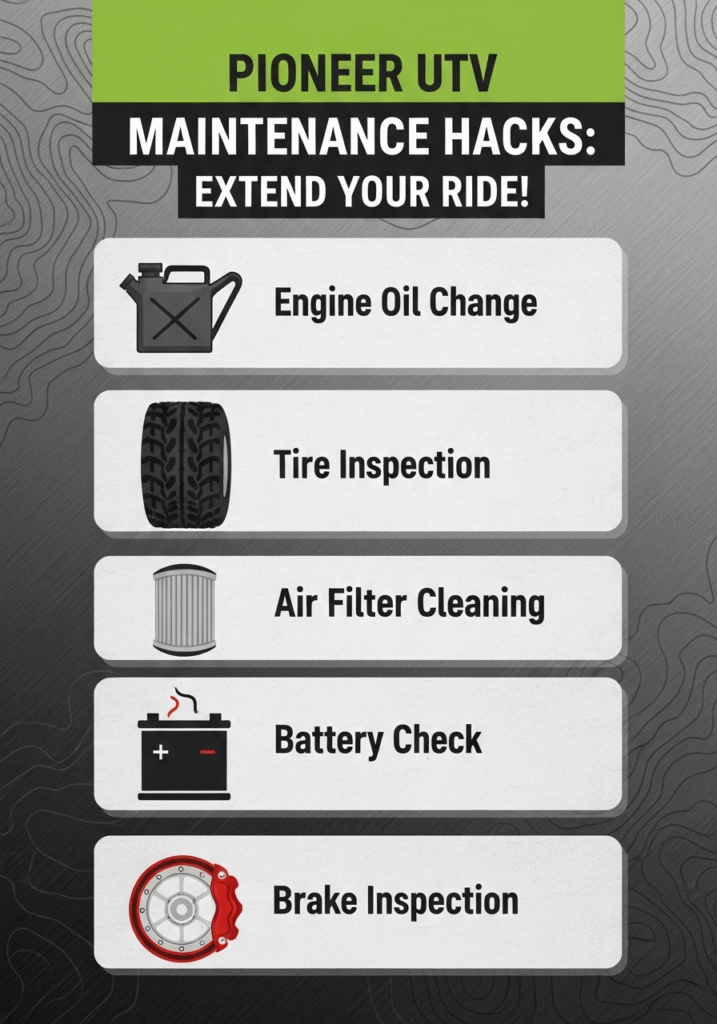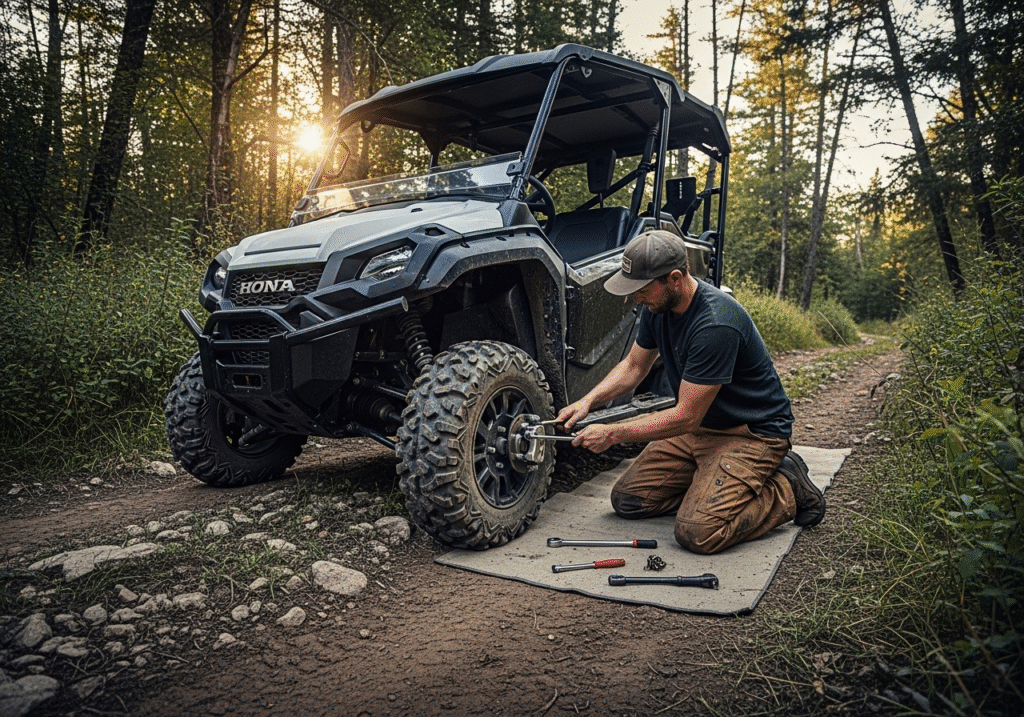The call of the wild trails is irresistible, and for many, a UTV is the perfect companion for adventure.
Specifically, the Honda Pioneer series has carved out a reputation for its rugged durability and reliable performance.
But even the toughest machines need a little love and attention to keep them running at their peak.
Just like any vehicle, consistent maintenance is the key to extending your UTV’s life, ensuring it’s always ready for your next off-road escapade.
In this comprehensive guide, we’ll dive into essential maintenance hacks that will help you keep your Pioneer UTV in top-notch condition, allowing you to conquer more trails and create lasting memories.

Videos added as random thoughts 💭 💭 💭 💭…
The Foundation: Regular Inspections and Fluid Management
Think of regular inspections as your UTV’s routine health check-up.
Before and after every ride, a quick visual assessment can save you from bigger headaches down the line.
Start by checking high-wear parts like bearings, fittings, and joints for any stuck particles that could cause damage [1].
Take a good look at your UTV’s body and frame for visible signs of dents or cracks, which could indicate structural issues.
Don’t forget to test your lights and brakes to ensure they’re fully functional for safety on the trails.
Finally, always check under the vehicle for any signs of fluid leaks – a small leak can quickly become a major problem if left unaddressed [1].
Fluid management is paramount to your UTV’s longevity.
Engine oil, often considered the lifeblood of your UTV, needs regular attention.
For many UTVs, an engine oil change is recommended every 1500 miles [1].
For Honda Pioneer 1000 models, this interval is typically every 1200 miles [2].
It’s not just about changing the oil; it’s about monitoring its levels, color, and consistency frequently using the dipstick.
If the oil appears dark, dirty, or has a foul odor,
it’s time for a change, along with a new oil filter to keep your engine clean and performing optimally [1].
Coolant levels are equally important for preventing your engine from overheating.
Before each ride, check the coolant reservoir to ensure it’s not hazy, discolored, or contaminated with particles.
Inspect the radiator cap and hoses for any brittleness, cracks, or leaks.
If you notice consistently low coolant levels, investigate for loose fittings or leaks.
Replacing your coolant once per season helps maintain the seals and extends your engine’s life [1].
Don’t overlook other vital fluids. Regularly check your transmission oil, brake fluid, and differential fluid.
While specific intervals vary by model, ensuring these fluids are at their correct levels and are clean will significantly contribute to your UTV’s smooth operation and prevent premature wear on critical components [3].
Powering Through: Engine, Air, and Fuel Systems
The engine is the heart of your UTV, and proper maintenance of its supporting systems is crucial for consistent power and performance.
The air filter, for instance, acts as your engine’s lungs, preventing dirt and debris from entering and causing damage.
A dirty air filter can significantly reduce engine efficiency and even lead to premature wear.
It’s recommended to clean your air filter with an air gun and compressor, and if it’s heavily soiled, replace it after approximately fifty hours of usage [1].
Always consult your user manual to identify the exact air filter model number for your UTV.
Fuel stabilization is another often-overlooked aspect of UTV maintenance, especially if your vehicle sits for extended periods.
Modern fuels can degrade over time, leading to carburetor or fuel injector issues.
Using a fuel stabilizer can prevent this degradation, ensuring your fuel system remains clean and ready for action when you are [3].
Spark plugs are small but mighty components that ignite the air-fuel mixture in your engine.
Over time, they can foul or wear out, leading to misfires and reduced engine performance.
Regularly inspecting your spark plugs for wear and proper gapping, and replacing them as needed, will ensure optimal combustion and a smooth-running engine [4].
Keeping it Smooth: Drivetrain and Suspension
Your UTV’s drivetrain and suspension systems are crucial for navigating challenging terrain and providing a comfortable ride.
These components endure significant stress, making regular inspection and maintenance vital.
Lubricating fittings is a simple yet effective way to reduce metal-on-metal friction in the many moving parts that pivot, rotate, or slide against each other during operation.
Consult your manufacturer’s instructions to locate all fittings and identify the recommended type of grease.
Using a vehicle grease gun to lubricate these points will help your UTV run smoothly and extend the life of these critical components [1].
For Honda Pioneer models, paying attention to the sub-transmission oil is important.
For the Pioneer 1000, this fluid needs to be replaced at specific intervals, contributing to the longevity and smooth operation of the transmission [2].
Regularly checking for loose suspension components, worn wheel bearings, and damaged CV joints can prevent more serious issues and ensure your UTV handles predictably on the trails [5].
Stopping Power: Brakes and Tires
Reliable brakes and healthy tires are non-negotiable for safety and performance on the trails.
Your UTV’s brake system requires regular attention.
Check the brake pad thickness; anything less than an eighth of an inch typically means it’s time for replacement.
Inspect the quality and levels of your brake fluid, ensuring there’s no debris contaminating the reservoir.
Also, examine the rotors for any bends, chips, or wear and tear, as rocks and other trail debris can easily damage them [1].
Tires are your UTV’s direct contact with the terrain, and their condition significantly impacts ride quality and safety.
UTV tires naturally lose air pressure over time, so keeping a tire pressure gauge handy is a smart move for prompt adjustments on the go.
Always refer to your owner’s manual for the specific tire pressure requirements of your UTV.
To ensure even wear and extend their life, rotate your tires every 5000 miles [1].
Be mindful not to over-inflate your tires, as this can lead to uneven tread wear.
If you notice a prolonged flat, inspect the sidewall for damage, as it might indicate a need for replacement [1]
Electrical Vitality: Battery and Wiring
The electrical system is the nervous system of your UTV, powering everything from ignition to lights and accessories.
The battery, in particular, can be a source of frustration if not properly maintained.
If your UTV sits unused for extended periods, the battery can lose its charge and may even need complete replacement.
To prevent this, regularly charge your battery, especially during storage, using a battery maintainer.
This device prevents overcharging, self-discharge, and keeps your battery ready whenever you need it [1].
Beyond just charging, inspect your battery for loose wire connections, damaged lines, dirt build-up, and terminal corrosion.
For unsealed batteries, check for low electrolyte levels.
Addressing these issues proactively will significantly extend your battery’s life and prevent unexpected electrical problems on the trail [1].
Common electrical issues can also stem from poor splices and melted fuse box pins, so a thorough inspection of your wiring and fuse box can save you from frustrating breakdowns [6].
Common Issues and How to Prevent Them
Even with diligent maintenance, UTVs can encounter common issues.
Being aware of these and knowing preventative measures can save you time and money.
Battery Problems: As mentioned, battery issues are frequent.
Beyond regular charging and using a maintainer, monthly checks of battery posts for dirt and corrosion are crucial [7].
Clean any corrosion immediately to ensure good electrical contact.
Drive Belt Wear: The CVT drive belt is a high-wear item. Beyond visual inspection for glazing or cracking, pay attention to any slipping or loss of power, which are clear indicators it’s time for a replacement [8].
Suspension Issues: Loose suspension components, worn wheel bearings, and damaged CV joints can lead to poor handling and an uncomfortable ride.
Regular inspection during your pre-ride checks can help identify these issues early, allowing for timely repairs before they escalate [5].
Brake System Failure: While we’ve covered brake fluid and pads, also be mindful of the overall brake system’s responsiveness.
Any sponginess or unusual noises should prompt an immediate inspection by a qualified technician.
Tire Wear and Tear: Beyond proper inflation and rotation, avoid aggressive driving on hard surfaces, which can accelerate tire wear.
Inspect for punctures or sidewall damage after every ride, especially if you’ve been on rocky trails.
Engine Running Rough: If your UTV starts to idle roughly, sputter during acceleration, or experience sudden power loss, it could indicate engine issues.
Regular oil changes, clean air filters, and ensuring all fluid levels are correct are your first lines of defense against these problems [].
Electrical Gremlins: Beyond battery and fuse box checks, be vigilant for any flickering lights, non-functional accessories, or unusual smells.
These can be signs of underlying electrical problems, often stemming from poor connections or damaged wiring [6].
Overheating: While less common with proper coolant maintenance, overheating can occur,
especially in demanding conditions or if your UTV’s design (like certain windshields) restricts airflow to the radiator.
Ensure your radiator fins are clean and free of mud or debris, and consider aftermarket solutions if you consistently experience overheating [].
Conclusion
Your UTV is an investment in adventure, and with a little proactive care,
you can significantly extend its life and ensure countless hours of enjoyment on the wild trails.
By consistently performing regular inspections, managing your fluids, and paying attention to the vital systems of your Pioneer,
you’ll not only prevent costly breakdowns but also enhance your riding experience.
Remember, a well-maintained UTV is a reliable UTV, ready to tackle whatever the off-road world throws its way.
So, get out there, explore, and enjoy the ride, knowing your Pioneer is built to last, thanks to your diligent maintenance efforts.








